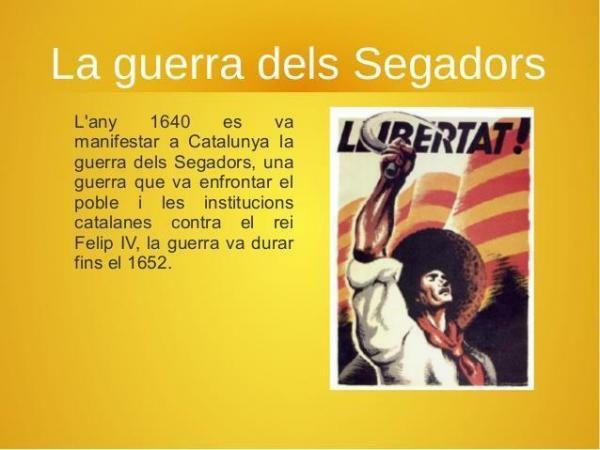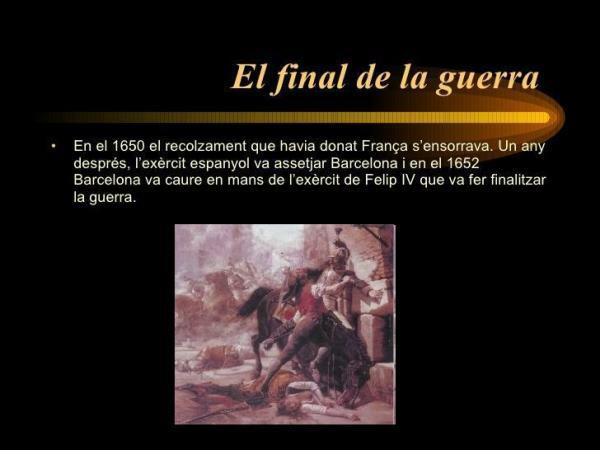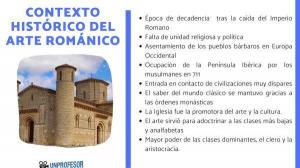Guerra dels Segadors: brief summary

The XVII century It was a period of time with great political movement, happening very important events for the history of Spain. Some of these movements were revolts in different parts of Spain, those that happened in Catalonia being especially important. To understand this stage, today in this lesson from a TEACHER we are going to offer you a brief summary of the Guerra dels Segadors.
The Reaper War, also known as uprising of Catalonia or war of Catalonia, It was a warlike conflict between Spain and a union of Catalonia and France that took place between 1640 and 1652. To understand this event we must learn about its background.
The situation of Castile at this time was quite delicate, the continuous wars against other states had made the area lost population and economic power, which made the Spanish Crown lose both military level and economic. This, together with the wars they faced, made the valid of King Felipe IV, the Count-Duke of Olivares, had to carry out a project that will change the situation in the country.
The Count-Duke of Olivares carried out two projects, one the Secret Memorial and the other the Union of Arms. The Secret Memorial was a report that spoke of the need to change the system of the monarchy, uniting the laws and institutions of all regions, to ensure that the royal power will increase. On the other hand, the Union of Arms, was a project according to which all the kingdoms, states and manors that belonged to the Hispanic Monarchy they had to give soldiers and money to the Crown, being proportional to the population of each region.
The Arms Union project
This project was not equally well received in the different Courts of the states belonging to the Hispanic Crown. The Castilian regions were delighted with the measure, but the rest of the areas they did not agree, since they did not like the idea of helping a Castile in crisis through her money.
Felipe IV summoned the Cortes of the different states that belonged to the Crown of Aragon, getting the support of Valencia and Aragon, although the king had to change some of his plans to get it. On the other hand, the Cortes in Catalonia were much more complicated and the king left after tough negotiations without closing the Cortes, proclaiming the Union of Arms, without any agreement with Catalonia. A few years later, Olivares tried again to get the Catalan Courts to approve the Union of Arms, but after another failure the king left again without closing them.
With all this situation on the edge, in 1935, Spain went to war with the France of Louis XIII, who took the war to Catalonia, where the Union of Arms marched to confront the French. The problems did not take in appearing, arising differences between the local troops and the rest, due to the lodging and maintenance and the sacking of Palafrugell on the part of the Castilian troops.
Due to all this, Olivares asks that measures be taken against all those who complain about the actions of the Castilian troops, which causes a increased fighting and a general insurrection in Girona.

To continue with this brief summary of the Guerra dels Reapers we must talk about the start of the War of the Reapers, which was caused by the deep crisis that had been caused by the events reported in the antecedents.
As we have already commented, in 1640 the peasants of Girona attacked the Castilian troops by the measures that the Crown had taken so that the Catalans did not complain about the actions of the Castilian troops. It did not take long for the Girona peasants to arrive in Barcelona, where they joined the Catalan reapers.
On June 7, 1640, during the feast of Corpus Christi, the reapers enter the city of Barcelona and they start the uprising. The attack focuses on Castilian officials, and ends with the death of the Viceroy of Catalonia, who was a faithful servant of the Count-Duke of Olivares. The revolt ended with 20 deaths, most of them royal officials, which was one of the causes of the total rupture between Catalonia and the Crown. This revolt, called Corpus de Sangre, started the War of the Reapers.
The War of the Reapers took place between 1640 and 1652, although its true end can be seen in the signing of the Peace of the Pyrenees in 1959. The conflict was not just a war between Spain and Catalonia, since the participation of France was vital for the duration of the conflict.
After the revolts, the Catalan oligarchy was unable to stop the social revolution, in which the peasants attacked the richest classes. In this situation, the governors of Catalonia asked King Louis XIII of France, enemy of the Hispanic Crown, for help. to stop the revolts while at the same time the Count-Duke of Olivares formed an army to recover the region.
Catalonia paid France to send men, at the same time that the Spanish army advanced, conquering important cities in Catalonia. A little later Louis XIII was elected as Count of Barcelona, and he defended Catalonia from the attack of the Spanish army. The army of Felipe IV left, taking 10 years to try again to recover the region.
After this began a conflict between Louis XIII and Philip IV who succeeded conquests. Louis XIII conquered Roussillon, Lleida and Monzón, but these last two took a short time to be recovered by Felipe IV. Little by little the French interest in Catalonia was decreasing, and this was used by Felipe IV to recover the area. After the taking of Catalonia, Felipe IV signed obedience to the Catalan laws and thus ended the Guerra dels Segadors, although he could not prevent France from staying with Roussillon.




